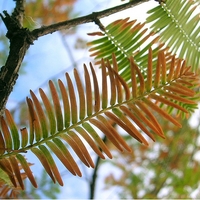Dawn Redwood : Description
The dawn redwood is a giant in nature, reaching heights of up to 160 feet. The trees' branches, stretching up and out at a gradual slope, can reach as far as 30 feet out. The largest of the dawns have a base diameter of about 6 feet. From its profile, it tends to take on the appearance of many other conifers, with a large base that tapers to a point, along with its branches. Mature dawns tend to fill out as vertical growth slows down, changing their appearance from conical to egg-shaped. The bark of this tree is truly remarkable, with a mosaic of light brown, grey, and red colors. At the base of the trunk, this bark is very soft and fibrous. It can be easily peeled away, and comes off in thin strands. The base of the trunk is also fluted, meaning it is very folded and warped. These folds lead directly into massive buttressed roots that appear to emerge from the ground in a tangled mess. These roots bend, entwine, and snake their way into the ground, giving insight into the complex underground network of long, thick roots. The bark toward the top of the tree is much more uniform. Persistent stems that stay on the tree all year round are mostly red and smooth. Although it is technically hardwood, these stems are soft to the touch. The deciduous stems are lime green, and fall off every winter. On these stems you can find a majority of the tree's leaves and cones. The leaves are small, flat, and symmetrical. They shoot out from the stem in a feather-like pattern, directly across from another leaf. They tend to be lime green in early development, and develop into a frost evergreen color by the late summer. In the fall, the dawn is known for its flashy red foliage. A very unique quality of the dawn is its cone structure. Each cone appears to be cubical from the top, but elliptical from the side. Woody, ovular segments just out of the reddish-brown segment in a beautiful and perplexing pattern.




